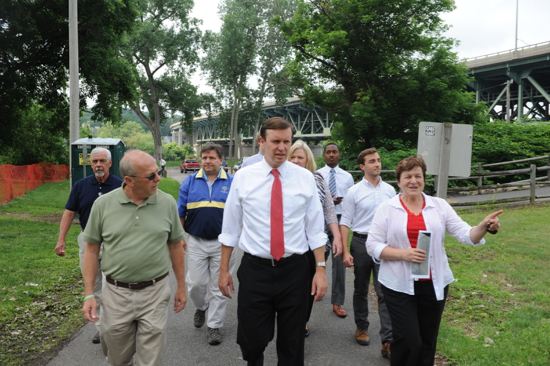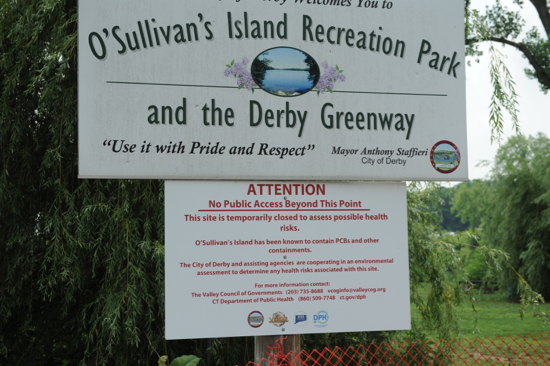 So far test results from contaminated soil at O’Sullivan’s Island show the dirt doesn’t pose a threat to the public — assuming you don’t dig a hole in the ground.
So far test results from contaminated soil at O’Sullivan’s Island show the dirt doesn’t pose a threat to the public — assuming you don’t dig a hole in the ground.
That’s the gist of a report prepared by the state Department of of Public Health and reviewed by the federal Department of Health and Human Services.
The report recommends that O’Sullivan’s Island be opened to the public — but it also states that more testing and remediation could be needed.
For that reason, Derby Aldermen decided to keep the area closed, at least until they receive the results from some recently completed groundwater tests.
U.S. Senator Visits
The O’Sullivan’s Island issue also has the ear of U.S. Sen. Christopher Murphy, who toured the land with state and local officials Wednesday (July 1).
Murphy stopped in Derby as part of a “brownfield listening tour.”
The federal Brownfield program helps to pay for the cleanup of contaminated sites.
Murphy said the state’s federal representatives are trying to learn more about the contaminated sites, including how the local municipalities could use them if they were free of contamination.
There are some 450 Brownfield sites between Stratford and Torrington alone.
Mayor Anita Dugatto, Aldermanic President Art Gerckens and Alderman Ron Sill explained the tortured history of O’Sullivan’s Island during the walking tour.
In addition, the local leaders said Derby needs funding to help clean up contamination within its nearby redevelopment zone.
“We’re trying to get a good sense of the priority projects,” Murphy said at the end of the tour. “The goal is that we’ll come up with a list of the top priority cleanup projects in the Route 8 corridor over the course of the summer.”
State Rep. Theresa Conroy, Derby Police Commission Chairman Thomas DeGennaro and Max Tanguary-Colucci of the Naugatuck Valley Council of Governments also went on the tour.
Contamination Update
Prior to the Senator’s arrival, the Alderman received an update on the O’Sullivan Island situation during a public meeting June 25 with Rick Dunne, executive director of the Naugatuck Valley Council of Governments.
O’Sullivan’s Island is a public park owned by the city. It is near the Derby Greenway, a walking path that stretches along the Housatonic and Naugatuck rivers.
O’Sullivan’s Island jets out into the water at the spot where the two rivers meet under Route 8.
Derby Aldermen restricted access to the land in January 2014, after concerns were raised over whether the soil was clean enough for recreational use.

The land has been the subject of two cleanups by the federal Environmental Protection Agency and was opened to the public in 2009. But those actions only concentrated on PCBs, and not the other contaminants known to be in the dirt.
In addition, the EPA cleanups did not completely clean PCBs (nor were the past cleanups designed to do that).
In addition to PCBs still in the dirt, there is also lead, arsenic, dioxins, petroleum hydrocarbons and a variety of volatile organic compounds.
The report concludes:
Any exposures to the contaminants in the surface soil (defined as the first six inches of dirt) “are unlikely to harm people’s health because exposure doses are not high enough to cause harmful health effects and cancer risks are not elevated.” This includes past or present exposures.
While there are dangerous concentrations of chemicals more than 1 foot below the surface, they don’t pose a threat — as long as you don’t start digging.
“If this was a residential property, they (the department of health) would not consider it safe,” Dunne said.
A copy of the report is embedded below. Article continues after the report.
O'Sully June 2015 Health Report
Simply walking on the grass field isn’t dangerous. Neither is cutting the grass. Dust from the soil isn’t a concern because there’s no dust issue, thanks to the grass.
“There is an assumption all throughout this report that there will be no penetration of the soil and that you’ll keep grass on it so dust doesn’t become airborne in large quantities,” Dunne said.
The report also concludes:
There are concentrations of contaminants in the soil “at a number of locations” that exceed state guidelines for environmental cleanups. “This indicated that further remedial actions may be needed in order for the site to be consistent with CT’s waste site cleanup regulations.”
Finally — PCBs are still in the ground in a few spots at concentrations that do not meet federal cleanup standards. That could mean parts of a dirt layer put down by the EPA a few years back could have washed away in a flood.
Dunne said there are two spots where PCB concentration is worrisome — under a pile of trees at the far end of the peninsula, and on the water’s edge, where it can’t be removed due to its location.
“You can open it, according to the DPH. You can open it and let people go out and use the site, but you’re still going to have exposure as the property owner for what’s buried in the site,” Dunne said.
In addition to seeking input from the state health department, Derby officials also want the state Department of Energy and Environmental Protection to essentially certify the land.
Dunne said his agency will continue to work on this issue, and said the city’s lawyer will eventually get involved to hammer out an agreement of some kind with state environmental regulators.
“What we ultimately want is to get DEEP to sign off on this site so there is no additional liability for the town,” Dunne said. “That liability is what we want to eliminate here.”